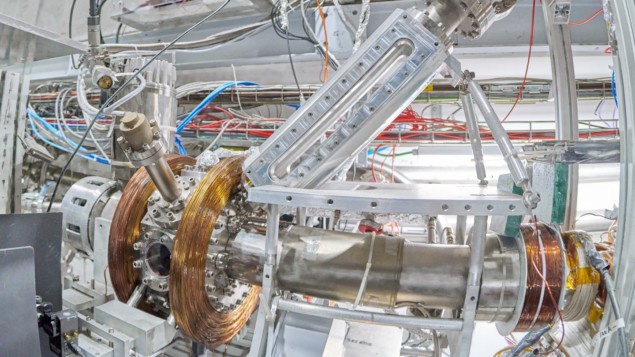
Researchers at CERN and the University of Tokyo have independently laser-cooled clouds of positronium. The breakthrough should make it easier to make precision measurements of the properties of antimatter and allow researchers to produce more antihydrogen.
Positronium is an atom-like bound state of an electron and its antiparticle the positron. As a hybrid of matter and antimatter, it is created in the lab to allow physicists to study properties of antimatter. Such studies could reveal physics beyond the Standard Model and could explain why there is much more matter than antimatter in the visible universe.
Positronium is currently created in “warm” clouds in which the atoms have a large distribution of velocities. This makes the precision spectroscopy difficult because an atom’s motion contributes to a slight Doppler shift in the light that it emits and absorbs. The result is a broadening of the spectral lines measured, making it difficult to see any tiny differences between spectra predicted by the Standard Model and experimental observations.
More antihydrogen
“There are several impacts of this result,” says the University of Oslo’s Antoine Camper, a laser physicist and member of AEgIS. “By reducing the velocity of positronium, we can actually produce one or two orders of magnitude more antihydrogen.” Antihydrogen is an antiatom comprising a positron and an antiproton, and is of great interest to physicists.
Camper also says that the research paves the way to use positronium to test current aspects of the Standard Model, like quantum electrodynamics (QED), which predict specific spectral lines. “There are very fine QED effects that you can probe with positronium because it’s composed of only two leptons and so is very sensitive to things like the weak force interaction,” he explains.
First propose in 1988, it has taken decades for the laser-cooling of positronium to be achieved. “Positronium is really uncooperative because it’s not stable,” says Jeffrey Hangst of Denmark’s Aarhus University. He is spokesperson for ALPHA, the antihydrogen experiment at CERN. “It annihilates itself after 140 ns and it’s the lightest atomic system that we can make, which brings a whole slew of difficulties.”
The atom’s short lifetime is partially due to the annihilation process between electrons and positrons. This means that laser pulses must interact with the positronium cloud faster than positronium decays.
The AEgIS team begins the cooling process by containing a cloud of positrons in a Penning trap. This uses static electric and magnetic fields to confine charged particles.
Then, the positrons are shot through a nanochannel silicon converter. After scattering and losing energy, positrons bind to electrons on the surface of the converter, creating positronium. This stage acts as a pre-cooling step before the positronium atoms are collected in a vacuum chamber, where they are laser cooled.
Photon interactions
The cooling process involves the atoms absorbing and re-emitting photons from a laser, losing kinetic energy in the process. The wavelength of the light is such that it is only absorbed by atoms moving towards the laser. These atoms then emit photons in random directions – cooling them down.
The team used a laser with an alexandrite gain medium, which Camper says is ideal because it produces a large spectral bandwidth that is able to cool particles with a large velocity distribution. Once cooled, the temperature of the positronium cloud is then measured with a probe laser. The AeGIS team was able to reduce its temperature from 380 K to 170 K.
“We have actually demonstrated that we are reaching the limit of efficiency of cooling for the interaction time that we used for traditional Doppler cooling,” said Camper.
New antimatter research
Managing to cool positronium to low temperatures could open up novel ways to study antimatter. Positronium is a good testbed for fundamental theories Hangst says, “There are two things that we should really understand in atomic physics, one is hydrogen and the other is positronium, because they only have two bodies.”
Precision spectroscopy can determine the energy levels of the positronium atom, and see whether they match with existing predictions made by QED. Similarly, the energy levels of positronium can be used to probe the effects of gravity on antimatter.

First positronium image recorded during a PET scan
However, Christopher Baker, an ALPHA physicist from Swansea University, says that scientists still have a long way to go before precision spectral analysis can be done. “To get something useful, we need to come down to about 50 K,” he said. There are still things the team can do to bring down temperatures, such as cryogenically cooling the target converters or bringing in a second laser.
“I think they’re on the right track, but it’s going to be more and more difficult to get colder and colder,” Baker said.
Hangst agrees that it will be a while before researchers can achieve their “pie in the sky” goal of creating a Bose–Einstein condensate out of positronium
The research is described in Physical Review Letters. In a preprint that has yet to be peer reviewed, Kosuke Yoshioka and colleagues at the University of Tokyo describe a new laser-cooling technique that has cooled a positronium gas.
- SEO Powered Content & PR Distribution. Get Amplified Today.
- PlatoData.Network Vertical Generative Ai. Empower Yourself. Access Here.
- PlatoAiStream. Web3 Intelligence. Knowledge Amplified. Access Here.
- PlatoESG. Carbon, CleanTech, Energy, Environment, Solar, Waste Management. Access Here.
- PlatoHealth. Biotech and Clinical Trials Intelligence. Access Here.
- Source: https://physicsworld.com/a/matter-antimatter-gas-of-positronium-is-laser-cooled/



